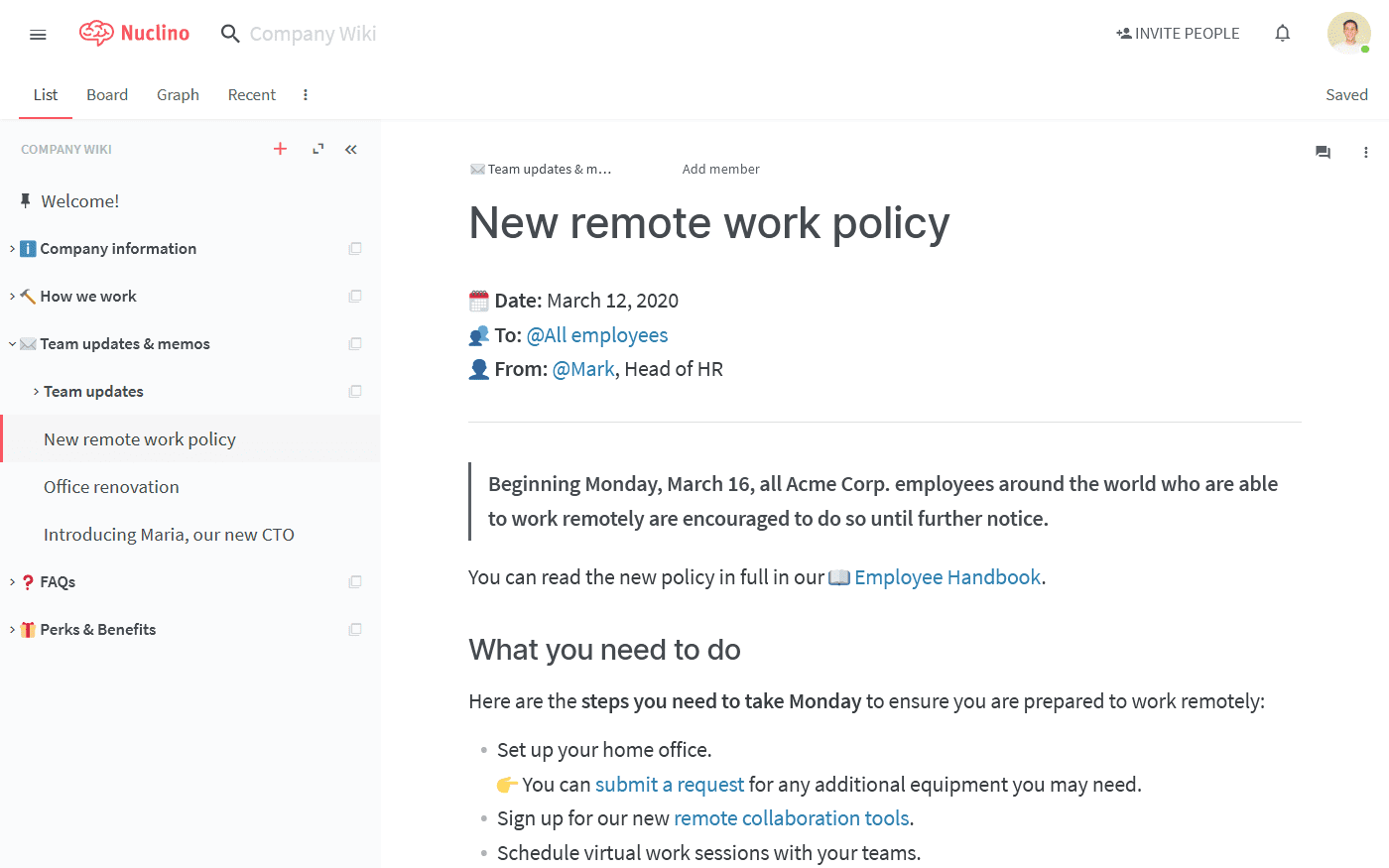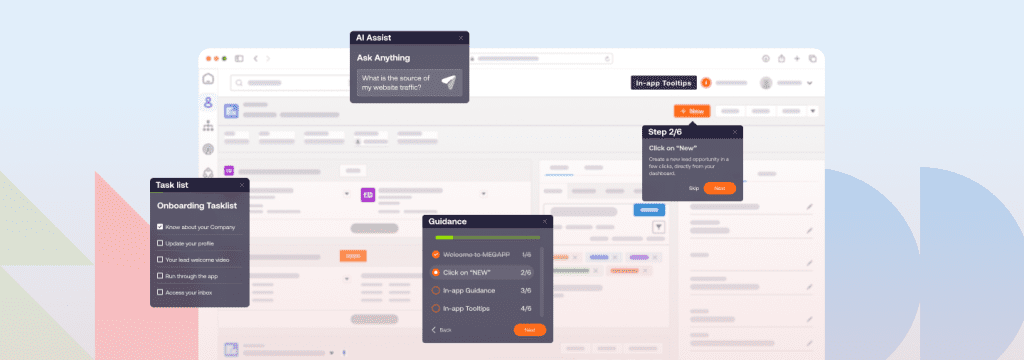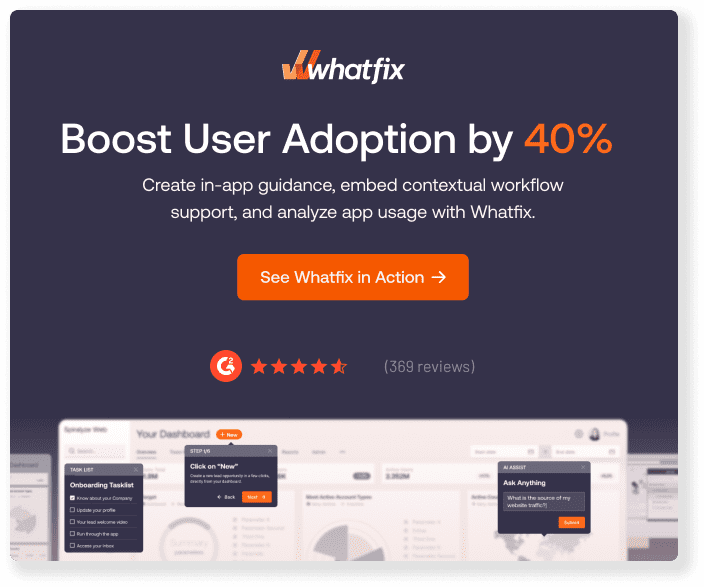Employees lose hours each week searching for the information they need to do their jobs. In fact, a recent workplace study found that 60% of employees struggle to get the knowledge they need from colleagues to complete tasks effectively. This not only slows productivity but also creates frustration, duplication of work, and missed opportunities.
For enterprise organizations, solving this challenge requires more than ad-hoc document sharing. Teams need structured, self-service access to policies, processes, and role-specific know-how. An internal wiki provides a single source of truth where employees can quickly find answers, collaborate, and share knowledge. By centralizing information, internal wikis reduce wasted search time, increase efficiency, and foster a knowledge sharing culture across the business.
In this article, we’ll explore what an internal wiki is, how it differs from other knowledge tools, the steps to build one effectively, and how Whatfix helps enterprises maximize adoption and ROI.
What Is an Internal Wiki?
An internal wiki is a centralized, collaborative knowledge hub where employees can create, edit, and share company-specific information in real time. Unlike static documentation stored in PDFs or shared drives, an internal wiki evolves continuously as teams contribute updates, making it a living, searchable source of truth for policies, processes, and best practices.
For CIOs, IT leaders, and knowledge management (KM) owners, an internal wiki is more than a content repository. It’s a foundation for operational scalability:
- CIOs see it as a way to reduce inefficiencies and improve ROI on digital transformation initiatives.
- IT teams value it for governance, permissions, and compliance at scale.
- Knowledge leaders use it to drive consistency, knowledge retention, and a culture of collaboration.
By combining accessibility with governance, an internal wiki ensures that employees can quickly find the information they need without overloading colleagues or IT support desks.

Above: Example of an internal wiki
Internal Wikis vs. Knowledge Bases vs. Intranet
While “internal wiki,” “knowledge base,” and “intranet” are often used interchangeably, they serve different purposes inside an enterprise. For CIOs and application owners, understanding these distinctions is critical to choosing the right tool for the right context. Here’s a quick comparison:
| Tool | Purpose | Ownership | Audience | Governance |
| Collaborative hub for employees to create, edit, and share company knowledge. | Typically knowledge management / IT + business unit contributors. | Internal employees | Flexible but requires content lifecycle policies, permissions, and regular reviews. | |
| Structured, authoritative repository of documentation, FAQs, and troubleshooting guides. | Usually owned by support, product, or IT teams. | Internal (employees) and/or external (customers/partners). | Highly controlled, curated content with approval workflows and versioning. | |
| Intranet | Centralized portal for company news, HR resources, and organizational updates. | Corporate communications or HR. | Entire org | Governance focused on consistency, branding, and access management. |
What to Include in an Internal Wiki
An internal wiki works best when it becomes the single source of truth for company-specific knowledge. The goal is to capture content that employees need repeatedly in their daily work, so they don’t waste time searching emails or messaging colleagues.
Here are the types of content typically stored in a wiki:
- Company policies and compliance guidelines: HR policies, expense rules, data privacy standards, and industry compliance requirements. (Owned by HR, Legal, Compliance)
- Standard operating procedures (SOPs): Step-by-step instructions for recurring tasks like onboarding, IT requests, or payroll. (Owned by Ops and IT)
- IT and product knowledge: Application how-tos, system access guides, troubleshooting workflows, and product release documentation. (Owned by IT, Product, Support)
- Organizational resources: Team directories, role descriptions, org charts, and internal project documentation. (Owned by HR, Ops, Business Units)
- Best practices and playbooks: Sales playbooks, customer service scripts, marketing campaign templates, and knowledge-sharing from subject matter experts. (Owned by functional leaders)
How to Create an Internal Wiki for Your Company
Building an internal wiki isn’t just about choosing a tool, it’s about designing a sustainable system that employees will actually use. Here’s a practical framework to guide CIOs, IT teams, and knowledge leaders through the process:
1. Assemble a team to own your organization’s wiki development and management
Your first step when creating an internal wiki is to gather your development team. Your team members will be dependent on the type of wiki you implement if you’re self-hosting, you’ll need developers. If you subscribe to cloud-based wiki software, select at least one employee who will be using the wiki regularly to get your end-users perspective.
You’ll also need to assign at least one project manager to keep the building process moving forward. Your other team members will vary depending on your needs, but do your best to include as many stakeholders as possible.
2. Plan and implement an internal wiki or knowledge base software solution
Once you’ve chosen your internal wiki software, it’s time to start building. First, get your team together to create an implementation plan that includes timelines for when the new wiki software will be ready for adding content.
It’s important to understand your organization’s needs and requirements before selecting a solution or face a failed software implementation that is both costly and time-consuming. Bring in key stakeholders from around the company to see what would be most helpful to them as well as all integrations that will be needed with existing software apps before shortlisting internal wiki vendors.
Internal knowledge base software helps streamline setup and future updates to your knowledge base. Additionally, the right internal knowledge base software provides tools that are customizable for your product or service. Our guide on the best knowledge base software to help inform your decision.
3. Assign owners for managing your company’s wiki content
While you’re in the building phase, figure out who will own and manage the content in your wiki. For example, your HR department is a good candidate for managing company policy documents, and your L&D department should manage information related to training.
Make sure to ask your employees early if they have existing content or information to speed up the content development process and determine who will upload your initial content and act as a content moderator or editor.
While it may be tempting to compile all of your documents in one place and send them off, thinking strategically about your internal knowledge base will help avoid confusion and chaos. Consider the following to build a list of resources your employees need:
- Reoccurring employee concerns and questions
- Common missteps employees take
- Out-of-date practices that you’ve meant to update or rethink
Another way to gather this information is to survey current employees to see what they want to learn and new employees about their onboarding experience. Again, find common themes and seek to address these in your internal knowledge base.
4. Upload content to your company’s wiki
Organize and categorize every piece of content that will go into your internal wiki. Once you have a logical structure in place, start uploading your content. As you start to place your content, take a look at the overall structure and make adjustments as needed. Be sure to consider tags and categories to help your wiki be easily searchable down the road.
5. Configure access rights and permissions
Determine who will be able to access the content in your internal wiki by setting your permissions and access rights. You can provide companywide access to your internal wiki, or you can restrict it to certain employees. Some wiki software will let you restrict access to certain documents or areas of your wiki, so decide now who needs access to what.
6. Launch with training and communication
A wiki is only successful if employees adopt it. Roll out with a communication plan, champions in each department, and short training sessions. Highlight “quick wins” like finding HR policies or IT how-tos to encourage daily use.
7. Ask for feedback from employees
Internal wikis are generally easy to navigate, but your people might need training to author content. Before deploying, let your employees know you are creating an internal wiki and share it with everyone who will have access. In addition, you can use your internal wiki to store onboarding documents so employees can learn how to use your wiki by actually working with it.
Common Challenges to Watch Out For When Building a Wiki
Even the best internal wiki platforms can fail if not managed properly. Here are the most common pitfalls enterprise leaders should prepare for:
- Content sprawl and duplication: Without strict governance, wikis quickly fill with redundant or outdated pages. Employees stop trusting the content, and the wiki loses credibility as a single source of truth.
- Over-customization: Adding too many custom features or workflows makes the system harder to maintain and upgrade. CIOs should prioritize out-of-the-box functionality and only customize where it drives measurable business value.
- Low adoption and resistance to change: Employees often default to old habits, like asking colleagues or digging through email, if the wiki feels overwhelming or irrelevant. Without proper training and change enablement, adoption stalls.
- Lack of governance ownership: A wiki without clear ownership and review cycles quickly becomes stale. Assigning accountable content owners in each department is critical to keep information accurate, current, and compliant.
Best Internal Wiki Software in 2025: Quick Comparison
Choosing the right internal wiki depends on your organization’s size, governance requirements, and AI ambitions. Here’s a quick snapshot of the leading options:
| Tool | Best For | Overview & CIO Appeal |
| Confluence | Mid-to-large enterprises | Offers strong governance, flexible page hierarchies, and deep integration with Jira/Atlassian tools. Ideal for organizations that need compliance, structure, and collaboration at scale. |
| Notion | Small teams and fast-growing companies | Lightweight, intuitive, and flexible. Combines docs, tasks, and wikis in one place. Great for teams that value speed and ease of use over heavy governance. |
| Document360 | Enterprises prioritizing AI search & analytics | A dedicated knowledge base + wiki solution with AI-powered search, version control, and advanced analytics. Gives CIOs visibility into adoption and knowledge gaps. |
| Guru | Sales & support knowledge hubs | Designed for “just-in-time” answers within workflows. Integrates with Slack, Teams, and browsers. Ideal for customer-facing teams who need instant access to trusted knowledge. |
| MediaWiki | Enterprises needing full control (open-source) | The platform behind Wikipedia. Highly customizable and scalable but requires IT resources to maintain. Best for enterprises that want maximum control over setup and governance. |
| SharePoint | Microsoft-centric enterprises | Part of Microsoft 365, doubling as a wiki and intranet. Strong compliance controls and seamless integration with Teams/OneDrive make it a natural fit for large enterprises already on Microsoft. |
| DokuWiki | Lightweight setups / SMEs | Open-source wiki that doesn’t require a database. Easy to deploy and maintain, making it ideal for smaller organizations with limited IT support. |
How Whatfix Accelerates Internal Wiki Success
Even the most well-structured internal wiki can fail if employees don’t adopt it, can’t find the right content, or stop trusting its accuracy. Whatfix acts as the enablement and adoption layer on top of your wiki ensuring the knowledge you’ve invested in is surfaced, used, and optimized for ROI.
1. In-app self-help that surfaces wiki content where employees work
Employees rarely leave the flow of work to open a wiki when they need help. Instead, they send a chat message to a colleague or submit an IT ticket. Whatfix eliminates this friction by embedding self-help directly into the enterprise applications your workforce uses daily (CRM, ERP, HR tools, collaboration platforms). When an employee searches or encounters a workflow step, Whatfix automatically pulls in relevant wiki articles, FAQs, and SOPs, giving them instant access to the right knowledge at the right moment.
Business impact: Reduced ticket volumes, faster task completion, and higher employee productivity.

2. AI-powered contextual answers with ScreenSense
Traditional wiki search often fails when employees don’t know the right keywords. With Whatfix AI and ScreenSense, users can ask natural-language questions (“How do I submit an expense in Oracle?”) and receive precise answers drawn from your internal wiki and connected repositories. The AI understands context, highlights the most relevant steps, and even shows where in the application to complete the task.
Business impact: Eliminates wasted search time, improves accuracy and compliance, and ensures policies and SOPs are consistently followed.
3. Guided onboarding and in-flow training
A wiki centralizes knowledge, but expecting employees to read documentation and apply it flawlessly is unrealistic. Whatfix bridges the gap by transforming static wiki content into interactive walkthroughs, tooltips, task lists, and smart tips embedded in your enterprise applications. New hires or teams adopting a new system can learn by doing with step-by-step guidance triggered in real workflows.
Business impact: Faster time-to-productivity for new employees, higher adoption of new processes, and reduced dependency on classroom training or LMS-only learning.
4. Analytics to measure usage and close content gaps
CIOs and knowledge leaders need to know if the wiki is working but most wiki platforms only provide basic usage stats. Whatfix goes further with adoption analytics, showing which wiki articles are being accessed, which search queries are failing, and where employees drop off in workflows. These insights help knowledge managers refresh outdated content, identify missing documentation, and quantify the impact of the wiki on efficiency.
Business impact: Data-driven governance, continuous improvement of knowledge assets, and proof of ROI on knowledge management investments.
FAQs on Internal Wikis
Who should own the wiki in an enterprise?
Ownership should sit with a cross-functional team. Knowledge management leaders or IT typically manage governance, permissions, and integrations, while business unit leaders are responsible for content creation and updates. This ensures the wiki remains both technically sound and business-relevant.
How do you keep wiki content fresh?
The most effective approach is to assign content owners to each page or category, set up automated review cycles, and use analytics to track which articles are being used. Regular audits help remove duplicates, retire outdated pages, and ensure employees trust the wiki as a single source of truth.
How can AI improve internal wikis?
AI enhances wikis by making knowledge more accessible and actionable. Tools like Confluence AI, Notion AI, and Document360’s AI search allow employees to ask natural-language questions and get precise answers or summaries. For CIOs, this means less time wasted on searches, higher adoption, and greater ROI, provided the underlying content is well-tagged, structured, and governed.
What’s the best way to measure success?
Key metrics include time-to-find information, search success rates, ticket deflection, employee onboarding speed, content freshness, and policy compliance. Tracking these KPIs gives CIOs and KM leaders visibility into whether the wiki is driving efficiency and helps justify continued investment in knowledge management.
Internal Wikis Click Better With Whatfix
An internal wiki can transform the way enterprises manage and share knowledge but only if employees adopt it, content stays accurate, and information is easy to find. Without the right enablement layer, even the best wiki platform risks becoming underutilized or outdated.
Whatfix ensures your investment in an internal wiki delivers measurable ROI. By surfacing content directly inside core applications, enabling AI-powered answers, guiding employees with in-flow training, and providing analytics on usage, Whatfix turns static documentation into a living, accessible system of knowledge.
Empower your teams, reduce time-to-find, and scale knowledge management with confidence. Book a demo with Whatfix
to see how.








